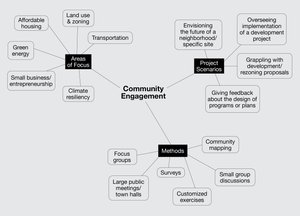Notes on Centering Communities: A framework for meaningful community participation at Pratt Center
From its inception, Pratt Center’s mission has focused on centering communities that have been historically excluded from public decision-making, in an effort to create more equitable urban plans, programs, and policies. We’ve always believed those directly impacted are the experts when it comes to their communities’ needs, challenges, and opportunities, and that the voices of residents who are Black, Indigenous, and People of Color (BIPOC) must be at the forefront.

In recent months, we have been reflecting on our community engagement (CE) work to date, and are determined to be more intentional about how we define, approach, and undertake this work going forward. This document aims to clarify and share our current thinking, open ourselves to questioning, and to inspire others in the field to undertake similar reflection.
At a very fundamental level, community engagement at Pratt Center means working in close partnership with BIPOC communities that have historically and systemically been excluded from decision-making to deliberately design opportunities to meaningfully participate in planning processs that impact their lives. It often involves outreach, bringing together and facilitating discussions, and information-gathering with groups of residents or stakeholders. Other times, it means breaking down technical information about land use processes or policy issues to make them more accessible to a broad range of people. Community engagement can also take the form of talking to community-based organizations, particularly those with deep community roots, who can serve as a proxy for community voice on various issues. Community engagement is critical to building power and the equitable distribution of resources.
Mapping Our Community Engagement Work

Over the past 60 years, Pratt Center has done a variety of community engagement projects. Some of the most common scenarios, areas of focus, and methods used in this work are mapped out below.
An Evolving Framework for Considering New or Emerging Community Engagement Partnerships
There are and will be times when it may not make strategic or values-based sense for Pratt Center to play a community engagement role. Below are thoughts and considerations to take into account when assessing a potential new project.
- Is the engagement with historically marginalized populations, and centering BIPOC communities?
- Is the engagement with people who genuinely represent the community (geographic or of affinity)?
- Is the request community-generated with a clear and viable community partner who’s building power and/or has deep roots in its community?
- Does the request for engagement come from a directly impacted community?
- Is there one or more clear community partner(s) that have the ability to actively participate in the project?
- Is it likely to have an impact on structural/systemic change and/or advancing racial, economic and climate justice?